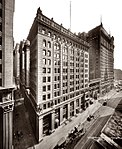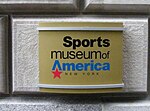Dubway Studios

Dubway Studios is an audio post and music production facility located in the Financial District of Manhattan, New York City. Services offered at Dubway Studios include tracking, recording, mixing, mastering, music production, voice-over sessions, and remote connections via Source Connect, phone patch, and Skype. Dubway's clients have included: HBO, Discovery Channel, Nick Jr. and Nickelodeon, PBS, Showtime, McDonald's, iTunes, IFC, NFL Films, Twentieth Century Fox, NPR, The New York Times, Antony & the Johnsons, Devendra Banhart, Patti Smith, They Might Be Giants, David Byrne, Cyndi Lauper, Dar Williams, Alicia Keys, Joseph Arthur, Dan Bern, Richard Barone, and Cat Power.
Excerpt from the Wikipedia article Dubway Studios (License: CC BY-SA 3.0, Authors, Images).Dubway Studios
Broadway, New York Manhattan
Geographical coordinates (GPS) Address Nearby Places Show on map
Geographical coordinates (GPS)
| Latitude | Longitude |
|---|---|
| N 40.706033 ° | E -74.012619 ° |
Address
Empire Trust Building
Broadway
10003 New York, Manhattan
New York, United States
Open on Google Maps









